Thunder from the gods. The Zeus Drive offers affordable yet divine overdriven tones in compact, road-ready housing. And I’ve had the chance to test one myself. Always a diva for distortion, I relished the opportunity to put the Zeus through its paces and see how it stacks up.
With its simple design, easy, flexible controls, and all-analogue circuitry, I was eager to get started. So, if you’re wondering how much tone you can get from a small, low-cost transparent overdrive, I’m here to answer that.
The gear I used
So that we’re all on the same page, I used two guitars to get a sense of how different pickups interact with the pedal: a Fender American Deluxe Strat (triple single coil) and an Epiphone Les Paul (dual humbuckers).
Throughout my test drive, I used the same combo amplifier, the Fender Super-Sonic 22-Watt, using both clean and distortion channels to fully explore the available textures. The pedal was the only effect applied, other than the amp’s built-in reverb.
Initial impressions
It’s small. Taking it out of the snug-fit packaging reveals a diminutive drive pedal that’s sure to fit on your board. Naturally, this brings some compromises, and one of them is the lack of a battery compartment. In most situations, that’s no trouble, but if you’re a light pedal user you may begrudge having to be chained to a power supply.
Power issues aside, once it’s plugged in, you’ll be greeted by an instant wall of sound. The volume control gives your output an almighty boost, instantly letting you know it’s engaged. During a quick preview test, with the amp on clean and volume set to 10 o’clock, it was obvious just how much the Zeus ramps up your signal. Hint: it’s a lot.
Controls
Beautifully simple. There are few controls present on the Zeus, making it easy to dial in your settings.
Drive
Clean and distorted, simultaneously. The dual-concentric Gain control blends overdrive through your clean channel, increasing clipping for additional crunch and adjusting the effect intensity.
At zero, there’s no drive applied, and the pedal will just function as a clean boost. As you raise it, it’ll steadily blend more overdrive into your dry signal, resulting in something that’s pretty much full drive when turned to the maximum.
Volume
Pretty self-explanatory, this affects the output level. Increase it to get loud. Seriously loud.
Treble
The Treble control cranks up the high end to focus on those piercing notes without compromising the bass registers. Functioning as a cut and boost, anything before the middle 12 o’clock position will cut treble from your signal, at the middle it’ll remain neutral, and after, the Zeus will start to ramp up the high end.
Fat switch
If things are still too treble-y, this switch will thicken up the sound by injecting more low-end into the signal. It’s perfect for enriching your bass.
Internal DIP switch
Probably the least like to be accessed, this internal switch lets you decide between True Bypass and Buffered Bypass. It’s extremely handy for those who run multiple pedals as you can choose how the pedal interacts with your signal. I left on True Bypass as it was the only pedal connected. Bear in mind that you’ll have to disassemble the pedal if you want to change this.
Getting started
Drive – 0, Volume – 75%, Treble – 0, Fat Switch – ON
Starting with the amp’s clean channel for a base sound, I rolled everything but the Volume and Fat switch back on the pedal. I wanted to get a sense of how the Zeus influences your tone with only a few settings active, and even then, the effect is remarkable.
On both guitars, I noticed a strong thickening of the sound, enhancing and projecting it further. I enjoyed this setting far more than I thought I would. It makes clean chords shimmer and glisten, lending detail to otherwise simple progressions.
Without the drive engaged, the effect on volume levels is less pronounced. This wasn’t a disadvantage, however, because it raised the signal just enough to remain enjoyable without introducing harsh, plosive bursts when a string is plucked too rapidly.
Cutting the treble and leaving the Fat switch engaged also leads to luscious, rich bass registers shining through. It’s perhaps why open chords felt so resonant and soulful.
This makes for an excellent base to modify further, or leave on permanently for a richer, creamier sound.
Drive – 50%, Volume – 75%, Treble – 50% (neutral), Fat Switch – OFF
Leaving the volume where it is and introducing drive and treble leads to a bit more bite entering your output. Without the Fat switch engaged, I noticed a much thinner yet louder sound.
This was more perceptible on the single coils of the Stratocaster than the humbuckers of the Les Paul, and similarly, the tone from both was quite different.
In all positions on the Strat, there was only the slight suggestion of breakup, unless I teased out more by adopting an aggressive pick attack. While lacking in distortion, all the tonal character of the guitar remained, just boosted with extra growl. It’d be excellent if you were looking to inject extra punch into the clean twang of single coils.
Change over to humbuckers and it’s a different story. The exact same settings yielded a fierce crunch that would fit right into classic rock. From subtle clipping to a guttural growl, this had me kicking into grooves.
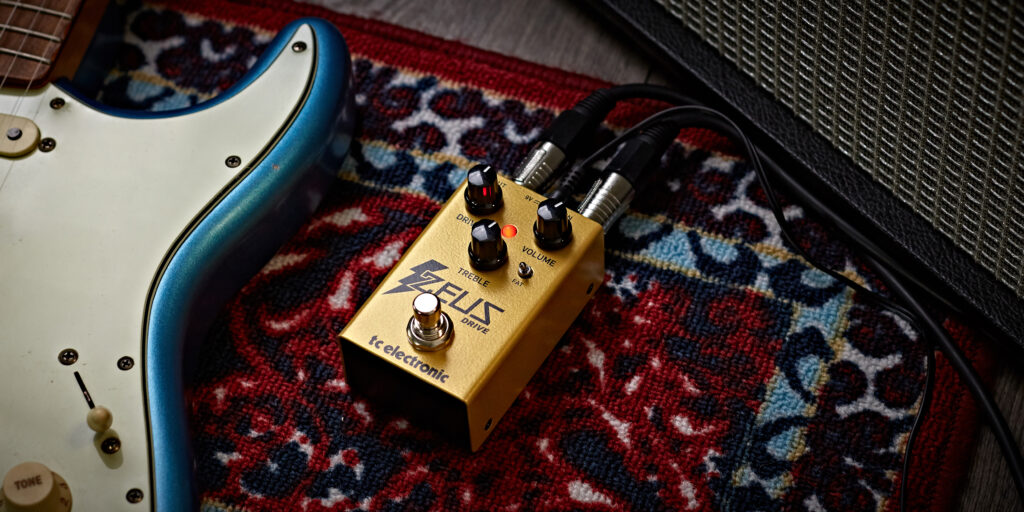
Drive – 75%, Volume – 40%, Treble – 50% (neutral), Fat Switch – ON
Searing, burning, a thunderclap from Mount Olympus, this is where distortion dives in. Even on the single coils, I was getting a smile-inducing amount of fuzz. Still not overbearing, it was the perfect amount of grit for those classic rock tones.
Humbuckers, on the other hand, roared with an even more vociferous voice. It was a fearsome rumble that would fit in well with heavier rock styles – perhaps even gusty enough for metal!
With this amount of gain introduced to the signal, there were abundant amounts of sustain on both guitars – making room for expansive solos and emphasised chords.
Same settings, increased Treble to 75%
Predictably, dialling up the treble resulted in a sharper, more piercing sound. I felt it worth mentioning, though, because anything past 50% acts as a treble boost. So, combined with the high amount of overdrive you’ll get access to some screeching, wailing sonics to fill out the higher registers.
With both settings this high, I’d recommend having the Fat switch engaged as it helps counteract the boosted highs.
Switching on the distortion…
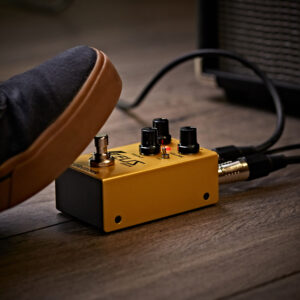
While I ran the Zeus Drive by itself with no other pedals, the Fender combo amp I used does offer a distortion-rich “Burn” channel with twin Gain controls. This acted in place of a distortion pedal in the chain to a clean amp, allowing me to get a sense of how the Zeus boosts an already clipped signal.
And the answer is, predictably, a lot.
At high drive settings, it’ll turn a tame, light crunch signal into a volcanic eruption of sound. Things like pinch harmonics and high-sustain string bends become exceptionally easy to perform thanks to the Zeus’s strong output.
With this much overdrive, the difference between single coil and humbucker was less noticeable, as both put out some ferocious crunch.
Personally, in this mode I found the Zeus to work best as a solo booster. Kicking it in for lead lines lent a jet-engine-like blast to each riff, giving real presence and definition when required.
Leaving the pedal on constantly worked great for some low-end chugging, especially when combined with the Fat switch to get an enriched bass. The slight drawback of this approach was losing the impact of engaging the Zeus mid-song.
Regardless of the setting though, the Zeus’ all-analogue circuitry combined with tube overdrive produced natural, warm, and raucous tones. With treble set past twelve o’clock, the textures may have been a bit too sharp for my liking, but nevertheless, if you’re looking to evoke a shrieking solo then it’ll work great for that.
Thoughts now that I’ve used it…
Construction
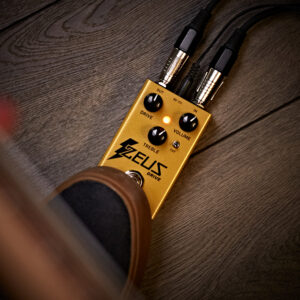
So, I’ve already mentioned the scaled-down size of the Zeus, but it bears repeating that its slim profile means it’s likely to fit on any pedalboard. And while there are smaller micro pedals than this, the top mounted jacks make it easy to connect.
One small gripe I had with the footswitch is that it only engages once it’s been depressed and released fully. This means that your boost arrives a split second later than you might expect, throwing you off the start of solos. Compared to stomp boxes like Tube Screamer which activate as soon as you depress them, it took some getting used to.
Otherwise, everything on the Zeus is sturdy, robust, and of good quality. Despite my reservations about the footswitch action, it’s evident that it’s going to survive a lifetime of gigging.
Tones
Running it through the clean channel led to a marked difference between my guitars. Notably, the humbuckers were more forceful, weighty, and voiced a much frothier distortion than the single coil Stratocaster.
I particularly enjoyed the clarity of the single coils when used with the Zeus, as the added depth and boosted output lent all aspects of playing additional textures. It really served to enhance the guitar’s tone rather than replace it, a hugely desirable quality for a drive pedal!
Fat switch
I loved this. It’s certainly a matter of taste, however, I pretty much always had it on. Perhaps It’s my ear that prefers a fatter, thicker bass, but I felt this nifty little switch really added punch to riffs and chords.
Treble
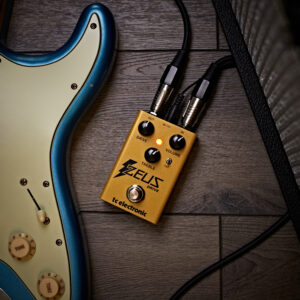
A feature I certainly preferred set at neutral, and on the Stratocaster, turning it down to cut the treble worked wonders. That said, the beauty of this setting is that it will clean up the high end if you want to send your tone soaring up the registers.
Drive
I loved the blend functionality of the drive – it means you can season your sound with just as much drive as desired. On single coils, I couldn’t bring out any spiky distortion until it was cranked up to the higher levels. However, all the stages before that allowed for a warm tonality with hints of breakup.
Verdict
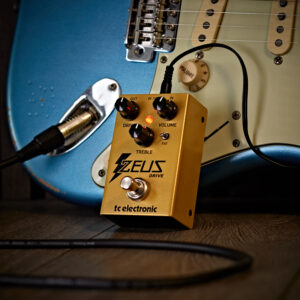
For its price, the Zeus Drive offers an enormous amount of tone. Able to enhance, thicken, and boost your sound without losing the details, it can serve up feisty rock flows or lay the base for heavier output.
With its all-analogue circuitry, you can expect a deliciously warm overdrive, superb for edge-of-breakup style sounds. I loved the variety of sounds this powerful pedal produces, and found the Fat switch to be a stand-out feature.
With its low cost and smaller footprint, it’s a must-have for any pedalboard.

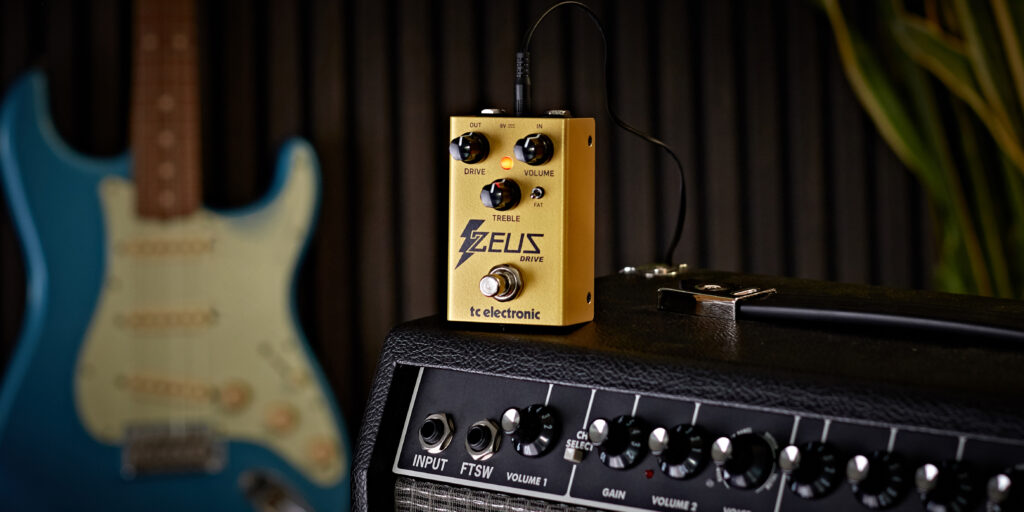
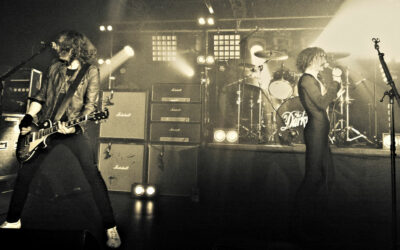

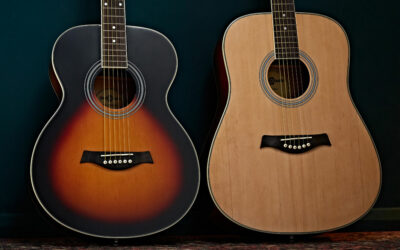

0 Comments